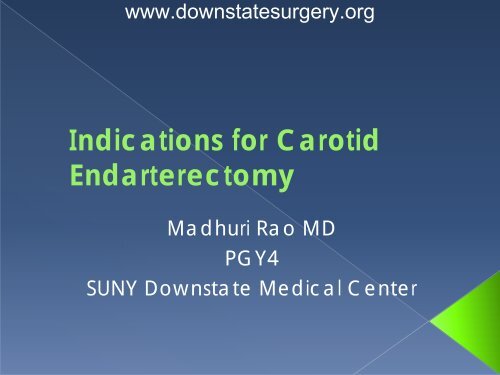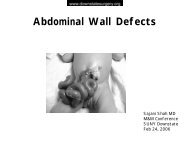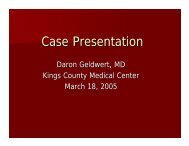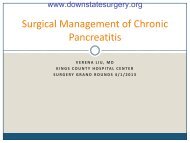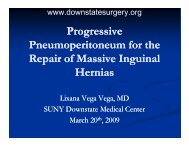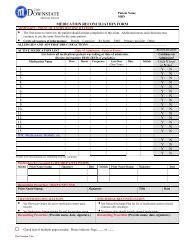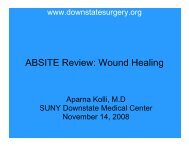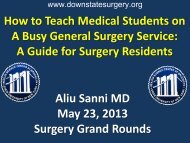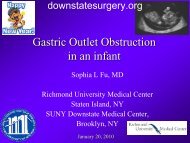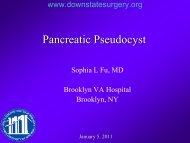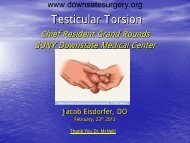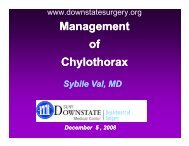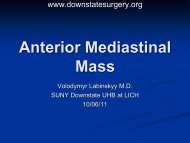Indications for Carotid Endarterectomy - Department of Surgery at ...
Indications for Carotid Endarterectomy - Department of Surgery at ...
Indications for Carotid Endarterectomy - Department of Surgery at ...
- No tags were found...
You also want an ePaper? Increase the reach of your titles
YUMPU automatically turns print PDFs into web optimized ePapers that Google loves.
Case Present<strong>at</strong>ionPre-oper<strong>at</strong>ive work-up Labs: unremarkable Imaging:www.downst<strong>at</strong>esurgery.org• <strong>Carotid</strong> Duplex: Right- normal velocities, no plaque;Left- 70-99% stenosis ICA, homogenous plaque bulbto proximal ICA• CTA neck: Left- Moder<strong>at</strong>e to severe stenosis <strong>of</strong> ICAfrom origin to 2cm, calcified plaque. Right-Moder<strong>at</strong>e stenosis <strong>of</strong> ICA from origin to 1.5cm
www.downst<strong>at</strong>esurgery.orgCase Present<strong>at</strong>ion
www.downst<strong>at</strong>esurgery.orgCase Present<strong>at</strong>ion
www.downst<strong>at</strong>esurgery.orgQuestions??
DiscussionOutlinewww.downst<strong>at</strong>esurgery.org Relevant definitions: TIA, stroke, carotid stenosissymptom<strong>at</strong>icand asymptom<strong>at</strong>ic Topics <strong>of</strong> discussion:• Diagnosis <strong>of</strong> carotid stenosis- best method• Degree <strong>of</strong> stenosis and rel<strong>at</strong>ion to stroke• CEA in symptom<strong>at</strong>ic p<strong>at</strong>ients- trials, indic<strong>at</strong>ions• CEA in asymptom<strong>at</strong>ic p<strong>at</strong>ients- trials andindic<strong>at</strong>ions• Role <strong>of</strong> carotid stenting Guidelines and recommend<strong>at</strong>ions
Definitionswww.downst<strong>at</strong>esurgery.org Transient Ischemic Attack (TIA)Old definition: Sudden onset <strong>of</strong> a focal neurologic symptom signlasting less than 24 hours, from transient decrease in bloodsupply rendering the brain ischemic in the area producing thesymptomNew definition: (AHA/ASA 2009 endorsed): transientepisode <strong>of</strong> neurologic dysfunction caused by focalbrain, spinal cord, or retinal ischemia, without acuteinfarction.
www.downst<strong>at</strong>esurgery.orgDiagnosis <strong>of</strong> <strong>Carotid</strong> StenosisCDUS as initial testCEMRA/CTA <strong>for</strong> additional in<strong>for</strong>m<strong>at</strong>ion
Degree <strong>of</strong> Stenosis and Rel<strong>at</strong>ion toStrokewww.downst<strong>at</strong>esurgery.orgAnnual Stroke Risk In Asymptom<strong>at</strong>ic P<strong>at</strong>ients -European <strong>Carotid</strong> <strong>Surgery</strong> TrialistsCollabor<strong>at</strong>ive Group, Lancet 1995; 345: 209
www.downst<strong>at</strong>esurgery.orgDegree <strong>of</strong> Stenosis and Rel<strong>at</strong>ion to Stroke
<strong>Carotid</strong> <strong>Endarterectomy</strong> in Symptom<strong>at</strong>icP<strong>at</strong>ientsNorth American Symptom<strong>at</strong>ic <strong>Carotid</strong> <strong>Endarterectomy</strong>Trial (NASCET)N Engl J Med 1991; 325:445-453www.downst<strong>at</strong>esurgery.org Medical management + CEA vs. medicalmanagement alone <strong>for</strong> symptom<strong>at</strong>ic carotid stenosis. Prospective randomized trial. Multicenter (50 US and Canadian centers with peri-opstroke and de<strong>at</strong>h r<strong>at</strong>e
<strong>Carotid</strong> www.downst<strong>at</strong>esurgery.org<strong>Endarterectomy</strong> in Symptom<strong>at</strong>icP<strong>at</strong>ientsPrem<strong>at</strong>ure termin<strong>at</strong>ion in 70-99% group A lower risk <strong>of</strong> any stroke or de<strong>at</strong>h (15.8 versus 32.3percent) 17% Absolute risk reduction 65% Rel<strong>at</strong>ive risk reduction
www.downst<strong>at</strong>esurgery.org<strong>Carotid</strong> <strong>Endarterectomy</strong> inSymptom<strong>at</strong>ic P<strong>at</strong>ients<strong>Carotid</strong> endarterectomy should be<strong>of</strong>fered to p<strong>at</strong>ients with symptom<strong>at</strong>ic 70-99% carotid stenosis
<strong>Carotid</strong> www.downst<strong>at</strong>esurgery.org<strong>Endarterectomy</strong> in Symptom<strong>at</strong>icP<strong>at</strong>ientsEuropean <strong>Carotid</strong> <strong>Surgery</strong> Trial (ECST) Multicenter randomized prospective trial Range <strong>of</strong> stenosis within which carotidendarterectomy confers st<strong>at</strong>istically proven benefit. Final report <strong>of</strong> 3024 pts. followed <strong>for</strong> 6 yrs• CEA was beneficial <strong>for</strong> symptom<strong>at</strong>ic carotid stenosis <strong>of</strong> 80 -99%• Increased risk <strong>of</strong> ipsil<strong>at</strong>eral stroke with > 80% stenosis
<strong>Carotid</strong> www.downst<strong>at</strong>esurgery.org<strong>Endarterectomy</strong> in Symptom<strong>at</strong>icP<strong>at</strong>ientsCochrane D<strong>at</strong>abase System<strong>at</strong>ic Rev. 2011: <strong>Carotid</strong>endarterectomy <strong>for</strong> symptom<strong>at</strong>ic carotid stenosis.Rerkasem.K. et.al. Published Online: 13 APR 2011. Cochrane Stroke Group Pooled analysis- 6092 pts- ECST, NASCET, VA
<strong>Carotid</strong> <strong>Endarterectomy</strong> <strong>for</strong>Asymptom<strong>at</strong>ic P<strong>at</strong>ientswww.downst<strong>at</strong>esurgery.orgAsymptom<strong>at</strong>ic <strong>Carotid</strong> Artery Stenosis Study(ACAS). JAMA. 1995;273(18):1421 Objective: CEA + aspirin vs aspirin alone in reduction<strong>of</strong> incidence <strong>of</strong> cerebral infarction in p<strong>at</strong>ients withasymptom<strong>at</strong>ic carotid artery stenosis. Randomized, prospective, multi-center trial 1662 adults, 40 – 79 yrs, 60 – 99% stenosis Primary end point - cerebral infarction in thedistribution <strong>of</strong> the study artery or any stroke or de<strong>at</strong>h inthe perioper<strong>at</strong>ive period
<strong>Carotid</strong> <strong>Endarterectomy</strong> www.downst<strong>at</strong>esurgery.org <strong>for</strong> Asymptom<strong>at</strong>icP<strong>at</strong>ientsMedian follow up <strong>of</strong> 2.7 yrs 5 yr stroke / de<strong>at</strong>h risk•11.0% medical group•5.1% surgery group Sub group analysis•ARR in men 8%•ARR in women 1.4%
<strong>Carotid</strong> <strong>Endarterectomy</strong> <strong>for</strong>Asymptom<strong>at</strong>ic P<strong>at</strong>ientsCochrane D<strong>at</strong>abase System<strong>at</strong>ic Rev. 2008: <strong>Carotid</strong>endarterectomy <strong>for</strong> asymptom<strong>at</strong>ic carotidstenosis. Chambers BR et. al. Cochrane Stroke Group3 studies, 5223 p<strong>at</strong>ients (3579 M and 1644 F)• ACAS(< 80yrs )• ACST• VA (men only)www.downst<strong>at</strong>esurgery.org• Follow up 2.7- 4 yrs
<strong>Carotid</strong> <strong>Endarterectomy</strong> <strong>for</strong>Asymptom<strong>at</strong>ic P<strong>at</strong>ientsResults Peri-op stroke/ de<strong>at</strong>h/ any subsequent stroke:• 31% RRR from CEA• ARR <strong>of</strong> 1% over 4yrs – VA study• ARR <strong>of</strong> 3% over 2.7 yrs – ACAS• ARR <strong>of</strong> 3.1% over 3.4 yrs – ACST Peri-op stroke/ de<strong>at</strong>h/ subsequent ipsil<strong>at</strong>eral stroke:• 29% RRR <strong>for</strong> CEAwww.downst<strong>at</strong>esurgery.org Peri-op stroke or de<strong>at</strong>h: 3.1%• Overall oper<strong>at</strong>ion rel<strong>at</strong>ed complic<strong>at</strong>ion r<strong>at</strong>e: 2.9%
<strong>Carotid</strong> <strong>Endarterectomy</strong> <strong>for</strong>Asymptom<strong>at</strong>ic P<strong>at</strong>ientswww.downst<strong>at</strong>esurgery.orgImplic<strong>at</strong>ions <strong>for</strong> practice Stroke and de<strong>at</strong>h r<strong>at</strong>e reduction by 30 % over3 yrs despite peri-op risk r<strong>at</strong>e <strong>of</strong> 3% ARR builds with time Men benefit more than women Insufficient d<strong>at</strong>a <strong>for</strong> older pts., younger pts.,different degrees <strong>of</strong> stenosis
<strong>Carotid</strong> www.downst<strong>at</strong>esurgery.orgArtery Stenting (CAS) Vs. <strong>Carotid</strong><strong>Endarterectomy</strong> (CEA)Cochrane D<strong>at</strong>abase System<strong>at</strong>ic Rev. 2012: Percutaneoustransluminal balloon angioplasty and stenting <strong>for</strong>carotid artery stenosis. Bon<strong>at</strong>i LH et. Al. Cochrane Stroke Group.16 trials involving 7572 p<strong>at</strong>ientsCAS a/w higher risk within 30 days• De<strong>at</strong>h or stroke ( p = 0.0003)• Odds R<strong>at</strong>io <strong>for</strong> primary safety outcome• 70yrs 2.20• p = 0.02CAS a/w lower risk <strong>of</strong>• MI• Cranial nerve palsy• Access/ surgical site hem<strong>at</strong>oma
CAS vs. CEA CAS – higher risk <strong>of</strong> peri-procedural stroke andde<strong>at</strong>h• In older p<strong>at</strong>ientswww.downst<strong>at</strong>esurgery.org CAS long term efficacy and r<strong>at</strong>es <strong>of</strong> restenosis- undetermined
www.downst<strong>at</strong>esurgery.orgSummary Of Recommend<strong>at</strong>ionsSymptom<strong>at</strong>ic <strong>Carotid</strong> Artery Stenosis (SVS) CEA is preferred to CAS <strong>for</strong> reduction <strong>of</strong> all-cause andperi-procedural de<strong>at</strong>h[grade I; level <strong>of</strong> evidence, B]. CAS over CEA if >50% stenosis and• tracheal stoma• prior ipsil<strong>at</strong>eral surgery or external beamradiotherapy,• lesions th<strong>at</strong> extend proximal to the clavicle or distalto the C2 vertebral body• Severe CAD, CHF, COPD[grade II; level <strong>of</strong> evidence: B].
www.downst<strong>at</strong>esurgery.orgSummary Of Recommend<strong>at</strong>ionsAsymptom<strong>at</strong>ic <strong>Carotid</strong> Artery Stenosis (SVS) >60% stenosis - CEA <strong>for</strong> reduction <strong>of</strong> long-termstroke risk• 3- to 5-year life expectancy• Perioper<strong>at</strong>ive stroke/de<strong>at</strong>h r<strong>at</strong>es 3%[grade I; level <strong>of</strong> evidence, A].CAS as primary therapy- insufficient d<strong>at</strong>a
Summarywww.downst<strong>at</strong>esurgery.org CEA <strong>for</strong> symptom<strong>at</strong>ic p<strong>at</strong>ients : 50-99 % stenosis CEA <strong>for</strong> asymptom<strong>at</strong>ic p<strong>at</strong>ients : 60-99% stenosis CAS : symptom<strong>at</strong>ic p<strong>at</strong>ients with surgical / medicalprohibitive risks No benefit <strong>of</strong> CEA• severe medical co-morbidities• Complete occlusion <strong>of</strong> ICA• Prior ipsil<strong>at</strong>eral disabling stroke Controversial topics• CAS• Long term benefits <strong>of</strong> CAS vs. CEA• Best Medical Therapy alone <strong>for</strong> asymptom<strong>at</strong>ic stenosisComparison <strong>of</strong> the five 2011 guidelines <strong>for</strong> the tre<strong>at</strong>ment <strong>of</strong> carotid stenosis Kosmas I. et al. J Vasc Surg 2012;55:1504-8
Referenceswww.downst<strong>at</strong>esurgery.org Comparison <strong>of</strong> the five 2011 guidelines <strong>for</strong> the tre<strong>at</strong>ment <strong>of</strong> carotid stenosis Kosmas I.Paraskevas, MD,a Dimitri P. Mikhailidis, MD,b and Frank J. Veith, MD,c,d Nürnberg, JVasc Surg 2012;55:1504-8.) Cochrane D<strong>at</strong>abase System<strong>at</strong>ic Rev. 2012: Percutaneous transluminal balloonangioplasty and stenting <strong>for</strong> carotid artery stenosis. Bon<strong>at</strong>i LH et. Al. Cochrane StrokeGroup. Cochrane D<strong>at</strong>abase System<strong>at</strong>ic Rev. 2008: <strong>Carotid</strong> endarterectomy <strong>for</strong> asymptom<strong>at</strong>iccarotid stenosis. Chambers BR et. al. Cochrane Stroke Group Management <strong>of</strong> asymptom<strong>at</strong>ic carotid <strong>at</strong>herosclerotic disease:Authors:Emile R Mohler,III, MD.Section Editor — Vascular Medicine Uptod<strong>at</strong>e- Nov 8 2012 Management <strong>of</strong> symptom<strong>at</strong>ic carotid <strong>at</strong>herosclerotic disease: disease:Authors:Emile RMohler, III, MD.Section Editor — Vascular Medicine Uptod<strong>at</strong>e- Oct 18 2012 Schwartz's Principles <strong>of</strong> <strong>Surgery</strong>, 9e
www.downst<strong>at</strong>esurgery.orgThank you
www.downst<strong>at</strong>esurgery.orgQuestions
Question 1www.downst<strong>at</strong>esurgery.org<strong>Carotid</strong> endarterectomy would be preferred tocarotid artery stenting <strong>for</strong> a(n):A. P<strong>at</strong>ient with severe three-vessel coronary arterydiseaseB. Recurrent stenosis 5 years after carotidendarterectomyC. P<strong>at</strong>ient with ankylosing spondylitis and severechronic obstructive pulmonary diseaseD. 82-year-old p<strong>at</strong>ient with a recent history <strong>of</strong>transient ischemic <strong>at</strong>tackE. 60-year-old p<strong>at</strong>ient with a history <strong>of</strong> neckirradi<strong>at</strong>ion
Question 1www.downst<strong>at</strong>esurgery.org<strong>Carotid</strong> endarterectomy would be preferred tocarotid artery stenting <strong>for</strong> a(n):A. P<strong>at</strong>ient with severe three-vessel coronary arterydiseaseB. Recurrent stenosis 5 years after carotidendarterectomyC. P<strong>at</strong>ient with ankylosing spondylitis and severechronic obstructive pulmonary diseaseD. 82-year-old p<strong>at</strong>ient with a recent history <strong>of</strong>transient ischemic <strong>at</strong>tackE. 60-year-old p<strong>at</strong>ient with a history <strong>of</strong> neckirradi<strong>at</strong>ion
Question 2www.downst<strong>at</strong>esurgery.orgCompared with carotid endarterectomy,carotid stenting <strong>at</strong> 30-day follow-up isassoci<strong>at</strong>ed with:A. A lower incidence <strong>of</strong> ipsil<strong>at</strong>eral strokeB. A lower incidence <strong>of</strong> non-f<strong>at</strong>al myocardialinfarctionC. A lower incidence <strong>of</strong> complic<strong>at</strong>ions inp<strong>at</strong>ients with <strong>at</strong>herosclerotic diseaseD. Better outcomes in asymptom<strong>at</strong>ic p<strong>at</strong>ientsE. A higher incidence <strong>of</strong> stroke and de<strong>at</strong>h
Question 2www.downst<strong>at</strong>esurgery.orgCompared with carotid endarterectomy,carotid stenting <strong>at</strong> 30-day follow-up isassoci<strong>at</strong>ed with:A. A lower incidence <strong>of</strong> ipsil<strong>at</strong>eral strokeB. A lower incidence <strong>of</strong> non-f<strong>at</strong>al myocardialinfarctionC. A lower incidence <strong>of</strong> complic<strong>at</strong>ions inp<strong>at</strong>ients with <strong>at</strong>herosclerotic diseaseD. Better outcomes in asymptom<strong>at</strong>ic p<strong>at</strong>ientsE. A higher incidence <strong>of</strong> stroke and de<strong>at</strong>h
Question 3www.downst<strong>at</strong>esurgery.orgWith regard to the Asymptom<strong>at</strong>ic <strong>Carotid</strong> AtherosclerosisStudy (ACAS), which <strong>of</strong> the following p<strong>at</strong>ients couldbe recommended <strong>for</strong> carotid endarterectomy ?A. A 65-year-old woman with 30% stenosis and complaints <strong>of</strong> lowerextremity claudic<strong>at</strong>ionB. A 70-year-old man with a carotid bruit and 60% stenosisrevealed on angiogramC. An 80-year-old woman with <strong>at</strong>rial fibrill<strong>at</strong>ion, complete lefthemiplegia, and a 30% stenosis on duplex ultrasound imagingD. A 70-year-old man with hyperlipidemia, a recent myocardialinfarction, and a 50% carotid stenosisE. An 80-year-old man with obstructive pulmonary disease and90% stenosis <strong>of</strong> the left internal carotid artery
Question 3www.downst<strong>at</strong>esurgery.orgWith regard to the Asymptom<strong>at</strong>ic <strong>Carotid</strong> AtherosclerosisStudy (ACAS), which <strong>of</strong> the following p<strong>at</strong>ients couldbe recommended <strong>for</strong> carotid endarterectomy ?A. A 65-year-old woman with 30% stenosis and complaints <strong>of</strong> lowerextremity claudic<strong>at</strong>ionB. A 70-year-old man with a carotid bruit and 60% stenosisrevealed on angiogramC. An 80-year-old woman with <strong>at</strong>rial fibrill<strong>at</strong>ion, complete lefthemiplegia, and a 30% stenosis on duplex ultrasound imagingD. A 70-year-old man with hyperlipidemia, a recent myocardialinfarction, and a 50% carotid stenosisE. An 80-year-old man with obstructive pulmonary disease and90% stenosis <strong>of</strong> the left internal carotid artery


